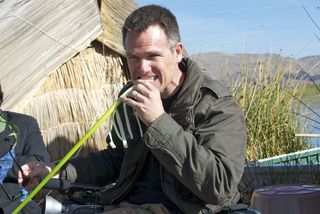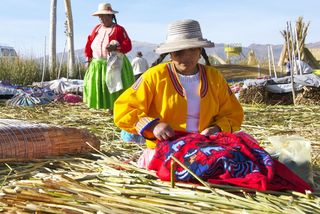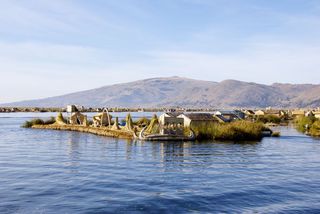 We landed in Cusco with a hotel booked for three days. Altitude adjustment claimed our first day, and the next day we spent wandering around with our new (super-helpful) friend Doris, looking for a place to live for the next few months. We found a place that day, but we couldn't move in until the end of the month. What to do? Hit the road again for a while. We took off for Lake Titicaca.
We landed in Cusco with a hotel booked for three days. Altitude adjustment claimed our first day, and the next day we spent wandering around with our new (super-helpful) friend Doris, looking for a place to live for the next few months. We found a place that day, but we couldn't move in until the end of the month. What to do? Hit the road again for a while. We took off for Lake Titicaca.
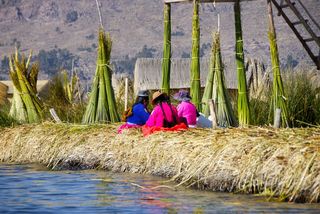 We went to Titicaca to see the Uros and their islands. The Uros are a pre-Inkan people who live on floating islands that they make out of reeds. That's right - artificial islands made entirely - of layers - of reeds! Each island is about 30 yards across, and has 5 to 8 houses on it. It's mind-blowing, really. Imagine the skill and knowledge, passed down through generations, that it takes to live life with such limited resources, in the middle of a gigantic lake. Humans are so full of ingenuity!
We went to Titicaca to see the Uros and their islands. The Uros are a pre-Inkan people who live on floating islands that they make out of reeds. That's right - artificial islands made entirely - of layers - of reeds! Each island is about 30 yards across, and has 5 to 8 houses on it. It's mind-blowing, really. Imagine the skill and knowledge, passed down through generations, that it takes to live life with such limited resources, in the middle of a gigantic lake. Humans are so full of ingenuity!
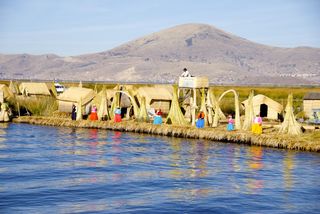 For years upon years these people lived and breathed the totora reed. They ate it, made rope out if it, used it to treat wounds... They made their houses out of it. They made their land out of it! They fished and hunted birds and birds eggs, and traded the totora reed with the mainland people for anything they couldn't provide themselves. Then things changed. The tourists discovered them. Now the islands are completely tourist-centric. The Uros spend their days making little toy boats, mobiles, and embroidered hangings for tourists to buy. They show us how they keep their islands floating, how they strip the reeds to eat the flesh, how they make their traditional boats, that they then take us out in for 10 soles per person.
For years upon years these people lived and breathed the totora reed. They ate it, made rope out if it, used it to treat wounds... They made their houses out of it. They made their land out of it! They fished and hunted birds and birds eggs, and traded the totora reed with the mainland people for anything they couldn't provide themselves. Then things changed. The tourists discovered them. Now the islands are completely tourist-centric. The Uros spend their days making little toy boats, mobiles, and embroidered hangings for tourists to buy. They show us how they keep their islands floating, how they strip the reeds to eat the flesh, how they make their traditional boats, that they then take us out in for 10 soles per person.
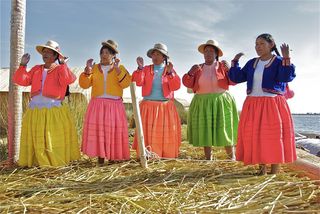 Humans are so full of ingenuity. These people have responded to a changing environment remarkably well. No doubt life is much easier for them now. Food is easier to come by, and things like rope and material come from the mainland. The family we talked with most, Willie, Amelia, and their four-year-old son Max, have a solar panel on their roof, and a TV and radio in their tiny hut. I asked Willie what work he spent the most time on each day: patching the island? collecting food? talking to tourists? He pointed to Max, sitting on the ground playing with matches, and laughed. My kinda guy!
Humans are so full of ingenuity. These people have responded to a changing environment remarkably well. No doubt life is much easier for them now. Food is easier to come by, and things like rope and material come from the mainland. The family we talked with most, Willie, Amelia, and their four-year-old son Max, have a solar panel on their roof, and a TV and radio in their tiny hut. I asked Willie what work he spent the most time on each day: patching the island? collecting food? talking to tourists? He pointed to Max, sitting on the ground playing with matches, and laughed. My kinda guy!
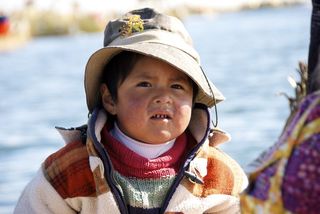 Not all of the islands have 'converted'. Thankfully - there are still Uros Islands where tourists don't tread, and things are done the way they always have been.
Not all of the islands have 'converted'. Thankfully - there are still Uros Islands where tourists don't tread, and things are done the way they always have been.
Our family has had long talks about the impact of tourism on cultures and environments. Tourists tend to talk about how 'the place has changed', with a dismayed shake of the head. But everything changes, with or without human intervention. Should we really wish for the world's people and cultures to stay stagnant? It's a hard question. One with no clear answer. But as a good friend says:
There is no answer. Seek it lovingly.
The floating islands are a fascinating place, and the people are warm, and welcoming, and kind. I'm glad I got the opportunity to meet them.